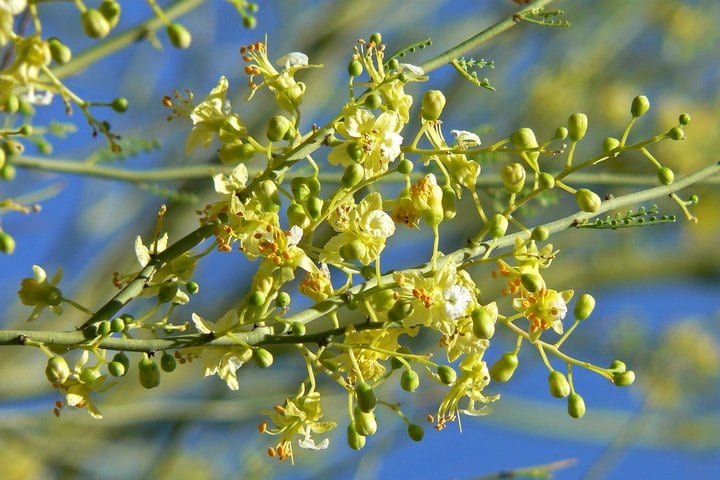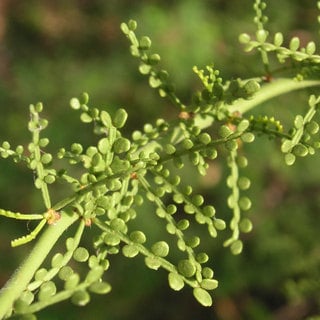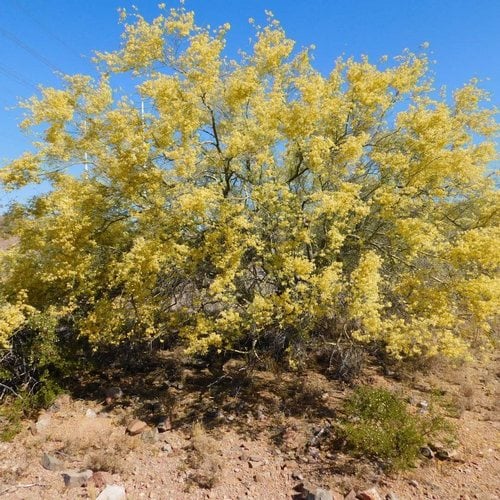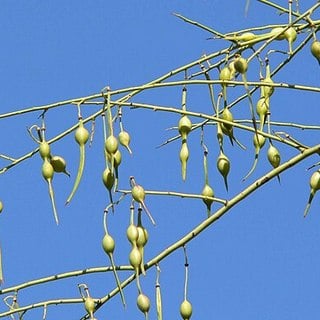Foothills palo verde is the most common tree in the Sonoran Desert, so it certainly will thrive in desert gardens with little-to-no care provided you get it off to the right start. Learn how to grow and what to expect from this lovely, medium-size tree when grown in the landscape.

Foothills palo verde (Parkinsonia microphylla) is a medium size tree with bright green bark and creamy yellow flowers that have one distinctive white petal. Flowers are followed by edible pods.
It’s one of the most common trees in the Sonoran Desert and is considered a keystone species. So it can easily handle harsh desert conditions in your yard.
It is about as low maintenance as a landscape tree can be, only occasionally needing water. In its native habitat, it survives on 3 to 12 inches of annual rainfall.
The name palo verde means “green stick”. The green stems and branches of palo verdes are covered with photosynthetic bark. Foothills palo verde has particularly tiny leaves and is intermittently leafless throughout the year, so the photosynthetic bark helps pick up the slack.
It’s a wonderful tree for attracting wildlife — hummingbirds, bats, butterflies, bees, and other insect pollinators feed on the nectar. It is a larval host for many species of moths. Birds and small mammals eat the seeds and use the tree for shelter.
Things I Like About This Plant
- Creamy yellow flowers
- Interesting gnarly trunks with green bark
- Very low water use
- Very low maintenance
- Supports wildlife
Things to Watch Out For
If you are looking for a lush, leafy tree, foothills palo verde isn’t it. Its leaves are small and inconspicuous, and since it loses its leaves in drought or cold, it is normally leafless some of the year.

While branches are not lined with thorns, each stem has a sharp, spiny tip.
Foothills palo verdes naturally have multiple trunks and look their best when allowed to sprawl, so this is not the right tree if you’re looking for a single-trunk “lollipop” tree.

Rabbits like to nibble on young trees. If they are a problem in your yard, protect a new tree with a temporary cage.
Spring allergies are often blamed on palo verdes,
but they are not a major culprit. Learn why here.
Optimal Growing Conditions
If you’re thinking of adding a foothills palo verde to your garden, you need to find a suitable place that will keep your plant healthy and looking good… while minimizing maintenance for you.
Here are the key factors to keep in mind.
Temperature
Foothills palo verde should be grown in USDA Hardiness Zones 8 – 10. It withstands both desert heat and cold, but it may suffer damage below 15℉.
Sun Exposure
While it can accept a little shade, this Sonoran Desert native does best in full sun.
Size and Growth Rate
Foothills palo verde grows slowly and typically reaches a size of 25 feet tall by 15 feet wide. These trees have a long lifespan and can live hundreds of years. They normally bloom in April or May.

Soil
Foothills palo verde grows well in well-draining rocky or sandy soil. This is not a good choice if you have clay soil, consider planting blue palo verde instead.
Don’t put organic mulch under the canopy of palo verdes, mulch with gravel or decomposed granite instead.
Pests & Diseases
Like other palo verdes, the foothills species is prone to witches’ broom, desert mistletoe, and the palo verde root borer beetle (Derobrachus hovorei).
Palo verde root borers are often blamed for damaging or killing palo verdes, but they are not considered a threat to healthy trees. The beetles spend no more than a month of their life cycle above ground and do not eat. Their grubs, which live underground for 2 to 4 years, mostly feed on dead wood of older or stressed trees.
Foothills Palo Verde:
The Essentials
| Common Name | Foothills palo verde |
| Scientific Name | Parkinsonia microphylla |
| Origin | Sonoran Desert |
| Plant Type | Semi-deciduous tree |
| USDA Zones | Zones 8 – 10 |
| Cold Hardiness | To 15℉ |
| Flower Color | Yellow |
| Flower Season | Spring |
| Mature Size | 25’ high x 15’ wide |
| Growth Rate | Slow |
| Sun Tolerance | Full sun |
| Water Needs | Very low |
| Pests & Diseases | Root borers, desert mistletoe, witches’ broom |
| Garden Friendly | Edible flowers, seeds |
| Cautions | Thorns |
| Wildlife | Attracts hummingbirds, butterflies, moths, bees |
How to Plant
The rule of thumb when planting any tree in the desert is to dig a hole three times as wide as the root ball but no deeper.
Amending the soil is not recommended. Counterintuitively, backfilling with the same native soil you just dug up helps your plant develop a stronger root system.
When to Plant
The best time to plant foothills palo verde is in the fall. This gives your tree three seasons to grow roots and get established before the following summer.
The second best time is in spring, the earlier the better. This still gives your plant time to get established before the intense heat of June arrives.
How to Care for Foothills Palo Verde
Whether you’ve recently planted a new foothills palo verde or have an existing one in your yard, here’s how to take care of it to keep it healthy and looking its best.
How to Water New Plants
Once you’ve got your foothills palo verde in the ground, watering is your most immediate concern. Here is the recommended watering schedule for new trees planted in the spring or fall.
| Weeks 1 & 2 | Every 3 – 4 days |
| Weeks 3 & 4 | Every 6 – 7 days |
| Weeks 5 & 6 | Every 7 – 10 days |
| Weeks 7 & 8 | Every 10 – 14 days |
After week 8, gradually extend the time between waterings.
How to Water Established Plants
As your tree becomes established, there are two watering factors to consider.
- First is how often to water. This will vary with the seasons.
- Second is how much water to give your tree with each watering. This depends on its current size.
To determine the ideal watering schedule for any desert tree, you’ll find everything you need to know, including easy-to-use charts, at How to Water Desert Trees: How Often? How Much?
Once established, you’ll only need to water deeply once per month in the summer. Foothills palo verde is the most drought tolerant of the palo verde species that grow in the southwest.
While it can survive on rainwater alone, it will look its best, grow faster, and be less prone to diseases with some supplemental water.
Should You Fertilize?
There is no need to fertilize palo verdes which evolved to grow in desert soil. And since these trees are members of the legume family (Fabaceae), they fix nitrogen, which naturally improves the surrounding soil.
How to Prune
This tree should be pruned as little as possible. The lower branches can gradually be removed to raise the canopy, but unless you are skilled in desert tree pruning, I urge you to have this work done by an arborist.
Don’t Confuse Foothills Palo Verde With…
Don’t confuse foothills palo verde with one of the other palo verdes that are often grown as landscape plants.
Desert Museum (Parkinsonia X ‘Desert Museum’) is a particularly showy hybrid that inspires awe every spring. It is a naturally-occurring hybrid of three palo verde species — foothills, Mexican, and blue.
Unfortunately, this gorgeous tree is extremely prone to storm damage. If you’ve ever seen palo verdes down after a storm, they are usually this species.
Blue palo verde (Parkinsonia florida) is a somewhat larger tree than foothills. It has larger leaves and bright yellow flowers that have orange-red dots on one petal and obvious orange stamens.
Plant Lover Facts
Foothills palo verde also goes by the common names littleleaf palo verde or yellow palo verde. It gets the name foothills because it usually grows on rocky slopes of the foothills of desert mountains. Its species name microphylla means “small leaf”.
Its native habitat includes parts of Arizona, California, and Northwest Mexico.
Palo verde is Arizona’s state tree. But since the legislators were not botanists, they failed to designate which palo verde. Consequently, both foothills and blue palo verdes are considered the state tree.
Foothills palo verde vastly outnumbers blue palo verde in the wild, by roughly 20 to 1.
Both flowers and seed pods are edible. Seed pods are sometimes compared in taste and texture to edamame. Native Americans consumed them raw, roasted, boiled, or ground into flour. They were largely considered a famine food to use when needed, rather than a part of their regular diet.

Did you enjoy this article?
Sign up for our weekly newsletter
where you’ll find more great info on creating &
maintaining a beautiful, carefree desert landscape.
Author Bio
Deane Alban is the creator of Southwest Gardener. She is a science writer with a bachelor’s degree in botany from the University of South Florida. Gardening is her lifelong passion. She’s been gardening in Tucson for over 15 years.

Photo Credits
Stan Shebs, CC BY-SA 3.0, via Wikimedia Commons
University of Arizona Campus Arboretum
Stan Shebs, CC BY-SA 3.0, via Wikimedia Commons
Stan Shebs, CC BY-SA 3.0, via Wikimedia Commons
